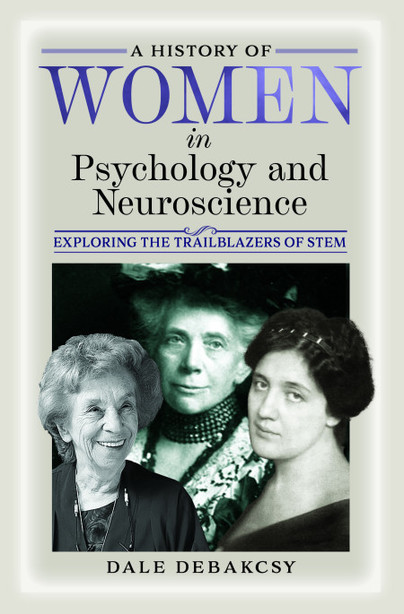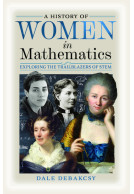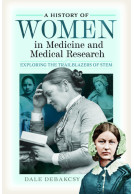A History of Women in Psychology and Neuroscience (Hardback)
Exploring the Trailblazers of STEM
Imprint: Pen & Sword History
Pages: 320
ISBN: 9781399032353
Published: 16th August 2024
(click here for international delivery rates)
Need a currency converter? Check XE.com for live rates
| Other formats available - Buy the Hardback and get the eBook for £1.99! | Price |
|---|---|
| A History of Women in Psychology… ePub (3.7 MB) Add to Basket | £6.99 |
Since virtually its first moments as an academic science, women have played a major role in the development of psychology, gaining from the outset research opportunities and academic positions that had been denied them for centuries in other branches of scientific investigation. Look wherever you will, in any branch of psychology or neuroscience in the last century and a half, and what you will find are a plethora of women whose discoveries fundamentally changed how we view the brain and its role in the formation of our perceptions and behaviors.
A History of Women in Psychology and Neuroscience tells the story of 267 women whose work opened new doors in humanity's ongoing attempt to learn about its own nature, from Christine Ladd Franklin's late 19th century studies of how the brain perceives color to Virginia Johnson's pioneering studies of the human sexual response, and Augusta Dejerine-Klumpke's early association of neurological conditions with their underlying brain regions to May-Britt Moser's Nobel-winning discovery a century later of the grid cells that allow us to mentally model our surroundings.
Here are the stories of when and how we learned how memories are formed, what role an enriched environment plays in mental development, why some individuals are better able to cope with chronic stress than others, how societal stereotypes unconsciously feed into our daily interactions with other people, what role evolution might have played in the formation of our social habits, what light the practices of sign language might shed on our brain's basic capacity for language, how children internalize the violence they experience from others, and hundreds of other tales of the women who dug deep into the structures of the human mind to uncover, layer by layer, the answers to millennia-old questions of what humans are, and why they behave as they do.
Rating: 5 out of 5 stars
NetGalley, Helen Hilton
This is a fantastic book. It took me a really long time to read it as it’s quite a tome but it’s worth it. There have been a lot of really excellent women in science and it’s great to celebrate them. It’s a very accessible read so not just for the psychology minded I think.
Rating: 5 out of 5 stars
NetGalley, Chelsea Dugan
⭐️⭐️⭐️⭐️⭐️⭐️⭐️⭐️⭐️⭐️ (10/5 stars)
This is the kind of book that makes you fall in love with science all over again. Dale DeBakcsy’s A History of Women in Psychology and Neuroscience is a sweeping, breathtaking tribute to the brilliant women who have not only shaped the field but, in many ways, created it. It’s not just a collection of names and dates—it’s a living, breathing history of female ingenuity, resilience, and determination. And if there’s one thing this book does with excellence, it’s making sure that the legacy of these women shines brightly, ensuring they receive the recognition that they’ve long deserved.
The moment you crack open this book, you are met with the undeniable truth: women have been a driving force in psychology and neuroscience since their inception. From the late 19th century to the present day, DeBakcsy tells the stories of 267 women whose breakthroughs have changed the way we understand the human mind. Their stories are carefully intertwined with the history of these fields, revealing not only what they discovered but also the often immense challenges they faced as women in science.
Each chapter feels like a love letter to these women, whether it’s Christine Ladd Franklin’s pioneering research into how the brain perceives color or May-Britt Moser’s Nobel-winning discovery of the grid cells that help us map our surroundings. There’s a sense of awe and deep respect in the way DeBakcsy presents these stories, allowing readers to truly appreciate the magnitude of their contributions. These are not footnotes in the history of science—they are the foundation.
One of the many things that stands out in this book is its humanity. These women weren’t just researchers—they were dreamers, innovators, and often trailblazers in a world that wasn’t always kind to them. Many of them, like Augusta Dejerine-Klumpke, fought against institutional barriers and societal expectations to make discoveries that would lay the groundwork for modern neuroscience. Others, like Virginia Johnson, pushed the boundaries of cultural norms by exploring topics that society was too squeamish to touch, such as human sexual response. Their perseverance in the face of discrimination, financial hardships, and the constant balancing act of personal and professional life is nothing short of inspiring.
DeBakcsy also does a phenomenal job of contextualizing their work. This isn’t just a biography of individuals; it’s a deep dive into the scientific questions that shaped their research. From understanding how memories are formed to exploring the neurological conditions that link behavior to brain function, the book explores the wide-reaching implications of these women’s work. And what’s more, it illustrates how their findings are not just historical footnotes, but continue to influence current research and debates in psychology and neuroscience today.
What makes A History of Women in Psychology and Neuroscience truly remarkable, though, is the way it ties together the technical with the personal. Yes, the discoveries are groundbreaking, but the real beauty of the book lies in the stories of these women’s lives—how they defied expectations, broke down barriers, and, in doing so, paved the way for future generations of women in STEM. It’s a reminder that science is not just about cold facts; it’s a deeply human endeavor. These women weren’t just changing their fields—they were changing the world.
The attention to detail in this book is astounding. Every woman’s story is carefully researched and lovingly told, from the early innovators like Christine Ladd Franklin to modern pioneers like May-Britt Moser. DeBakcsy takes great care to highlight the diversity of their backgrounds and fields of study, showing that women have been at the forefront of all areas of psychology and neuroscience—from cognitive psychology to behavioral neuroscience to neurophysiology.
But what truly sets this book apart is its ability to inspire. Reading it feels like being handed a torch lit by the brilliant minds of these women, and as a reader—especially one aspiring to join the ranks of women in STEM—you can’t help but feel empowered. You start to see yourself in these trailblazers, women who were once students, daughters, and dreamers, just like you. And when you read about their breakthroughs, their tireless efforts to push forward in a world that often pushed back, you realize that their story could one day be your story.
In a world where the contributions of women to science are often overlooked or forgotten, A History of Women in Psychology and Neuroscience is a bold, beautiful act of remembrance and celebration. It’s a must-read for anyone who is passionate about science, gender equality, or simply loves a good story of overcoming the odds. Whether you’re a budding neuroscientist, a psychology enthusiast, or someone who, like the author, wants to shine a light on these forgotten figures, this book will leave you not just educated, but moved.
In short, this is more than just a history of women in STEM—it’s a testament to the power of human determination, curiosity, and brilliance. It’s a book that should be proudly displayed on every scientist’s shelf and read by anyone who dares to dream of shaping the future of science.
If these women could read this book today, they would no doubt feel the same way I do: proud, seen, and incredibly inspired.
Rating: 5 out of 5 stars
NetGalley, Andrea Romance
This book celebrates the groundbreaking contributions of 267 women who revolutionized our understanding of the brain and human behavior. From color perception to intimate response, memory formation to social interactions, these pioneering women have made significant discoveries that continue to shape our knowledge of the human mind.
This book is arranged chronologically, more like encyclopedic entries than a narrative. Full of fascinating information, it can be read straight through or treated as a reference book.
Rating: 5 out of 5 stars
NetGalley, Kira Knight
It was great to learn about the women behind the theories and research in a historically male dominated field with a broad range of theories covered. I liked the brief portraits chapters, both for the early twentieth century and modern age, mixed in with the specific researchers and their work/theories. I also liked the photos at the end of some of the researchers, especially Anna Freud and Melanie Klein who I had read a lot about previously but never had a face to put to the name. Finally, the glossary is very helpful and I found the title entertaining (So … what does that mean? A glossary of frequently used but kind of weird terms).
Rating: 5 out of 5 stars
NetGalley, Ink Reads
A History of Women in Psychology and Neuroscience - Exploring the Trailblazers of STEM by Dale DeBakcsy is an absolutely fascinating insight into 267 female trailblazers in what is still the relatively young scince of Psychology and its contribution to soceity as a whole
While I experienced quite a balanced representation of both genders when I studied to MSc, in soceity, the contribution of women in the field is limited (but to be fair, many don't consider the field to comprise much more than Freud's theories, but I digress)
Concise, compelling and articulate, Dale Debacksy has compiled an essential record of some of the most significant contributions to the understanding of thought and beyond. A truly brilliant book.
Rating: 5 out of 5 stars
NetGalley, Didem Durak Akser
A History of Women in Psychology and Neuroscience is a non-fiction book about the women scientists of neuroscience and psychology. In this well researched and edited book, we learn about 267 women whose work helped shape the practices and understanding of mental health, brain, and cognition. As someone whose research topics is neuroscience and creativity, I had to read this book. I was not aware of many of the scientists in this book,
The further reading suggestions are helpful, and the book is comprehensive and informative. I enjoyed learning about these women’s contributions and discoveries, as well as the stories of the discoveries themselves.
About Dale DeBakcsy
Dale DeBakcsy has written the popular bi-weekly Women In Science column at Women You Should Know (www.womenyoushouldknow.net) since 2014, creating a freely accessible archive of in-depth and rigorously researched articles detailing the history of women professionals in all branches of STEM. For three years, he was the author and illustrator for the History of Humanism series at New Humanist, and is a contributing author to the Great Minds column at Free Inquiry Magazine. His essays have appeared in Philosophy Now, The Freethinker, Skeptical Inquirer Magazine, American Atheist Magazine, The Humanist, and Free Inquiry Magazine. From 2007 until 2018, he (under the incredibly classy pseudonym Count Dolby von Luckner) and Geoffrey Schaeffer co-wrote the historical satire webcomic Frederick the Great: A Most Lamentable Comedy Breaching Space and Time, and in 2016 he published The Cartoon History of Humanism at The Humanist Press. By day, he is an instructor in world history, mathematics, and science in the beautiful California Bay Area. By night, he is… very tired. He is the proud father of two girls, two cats, and four chickens. This is his first book for Pen and Sword Books.



















